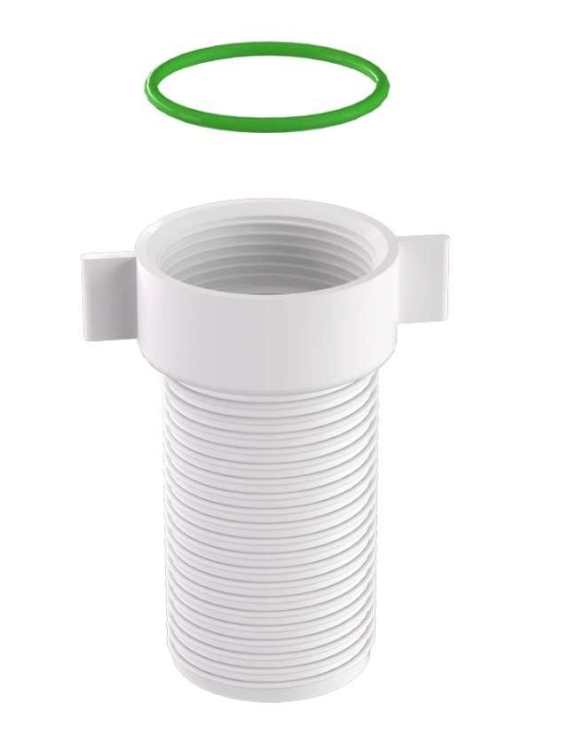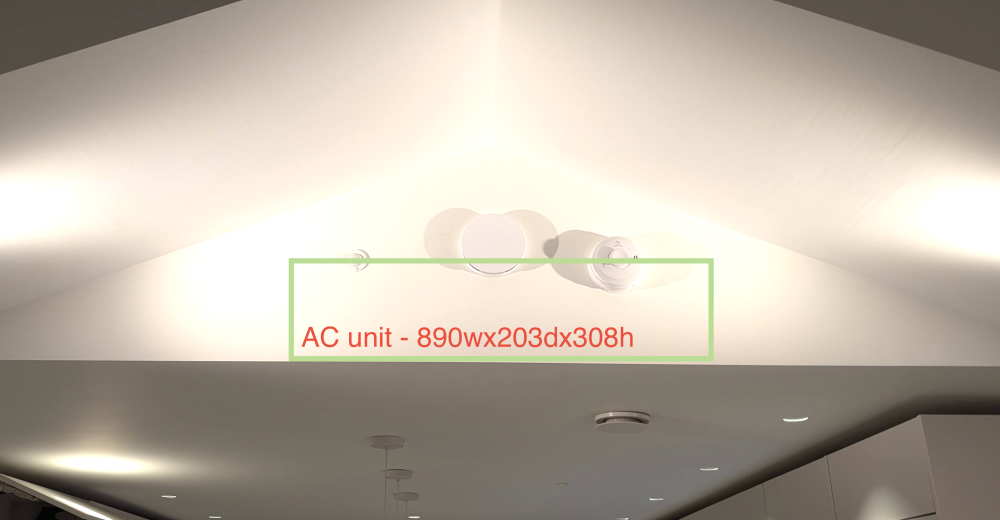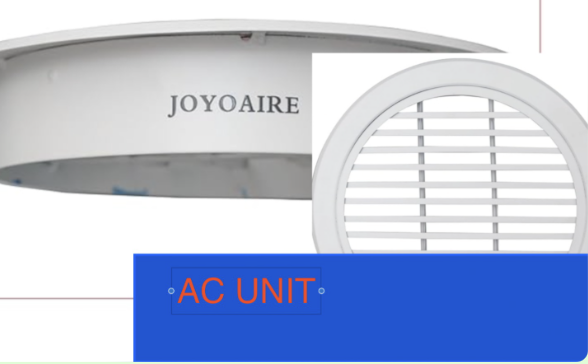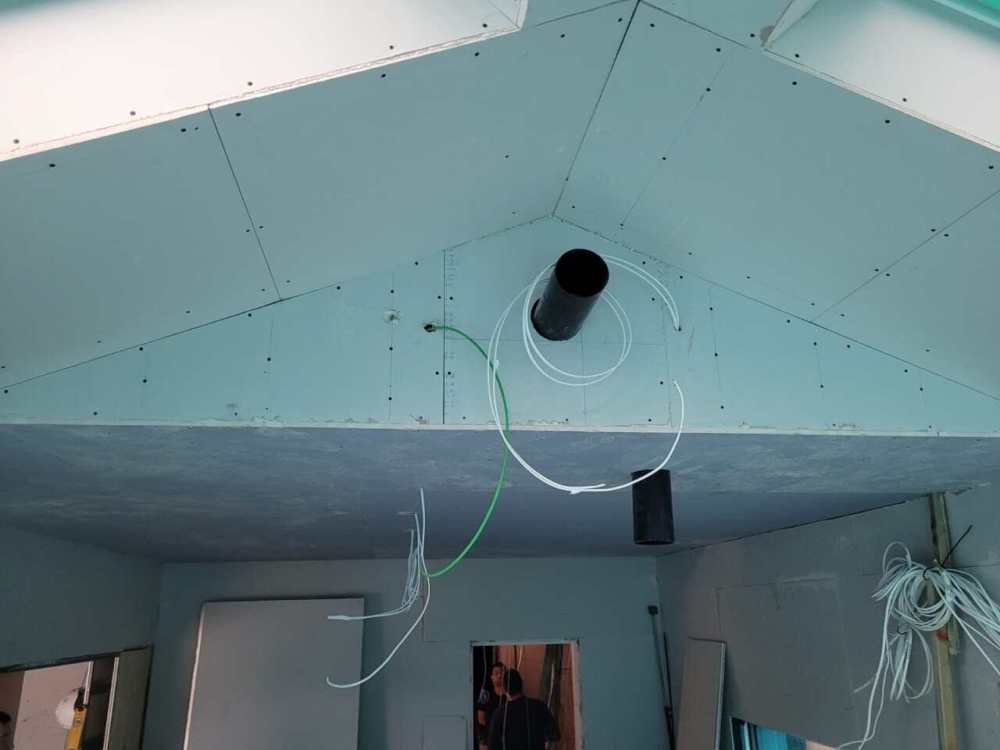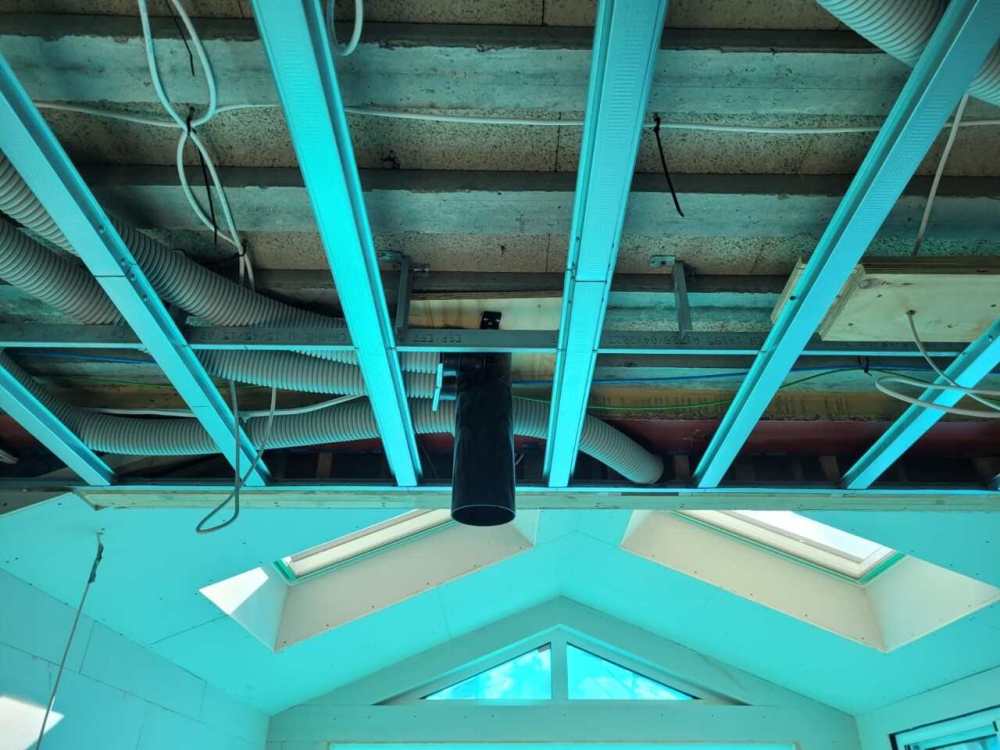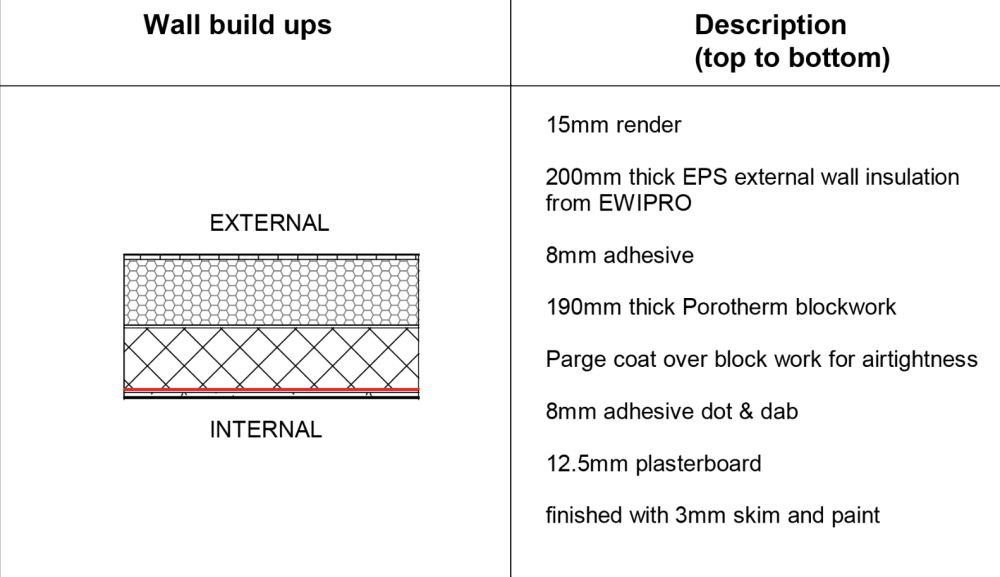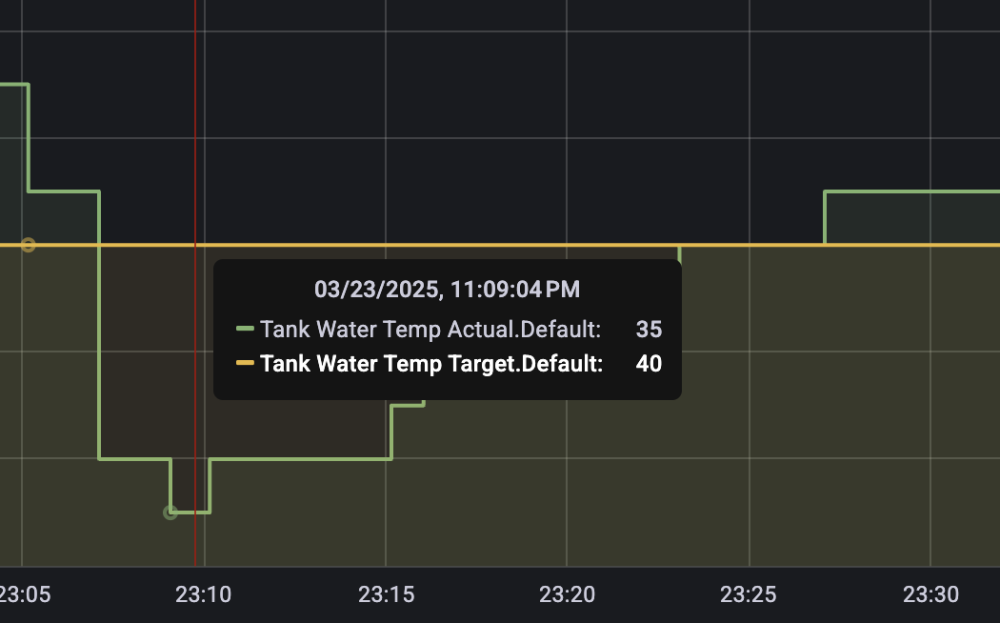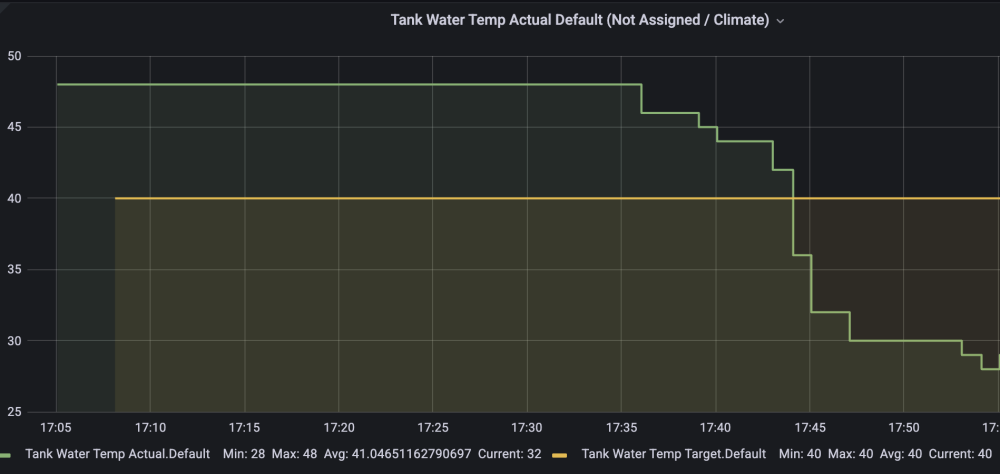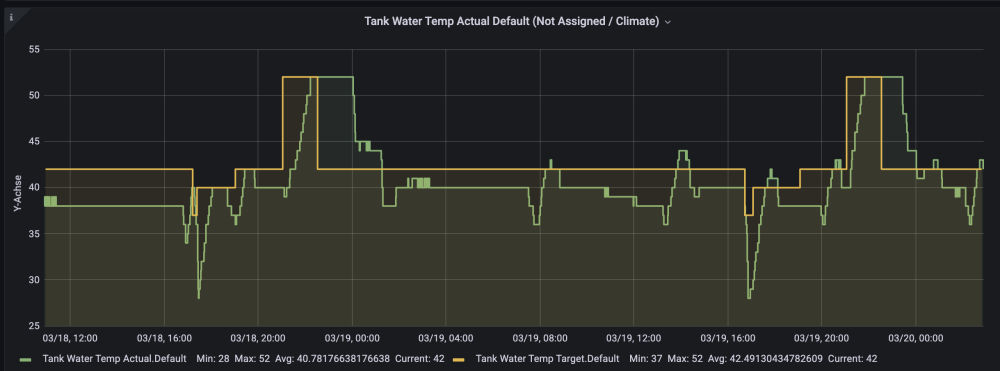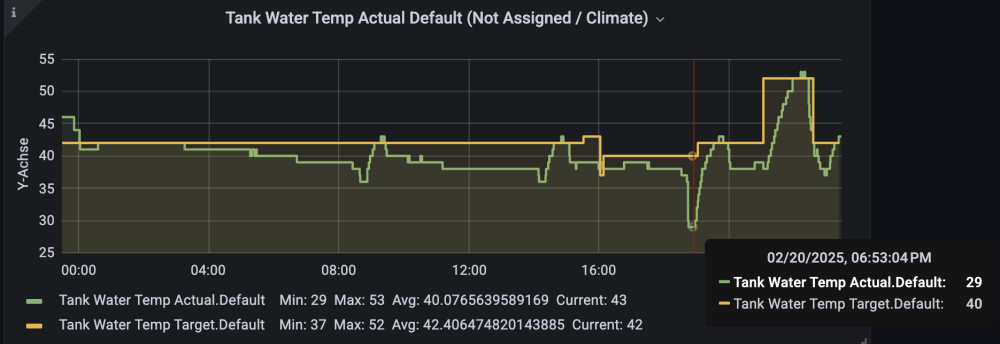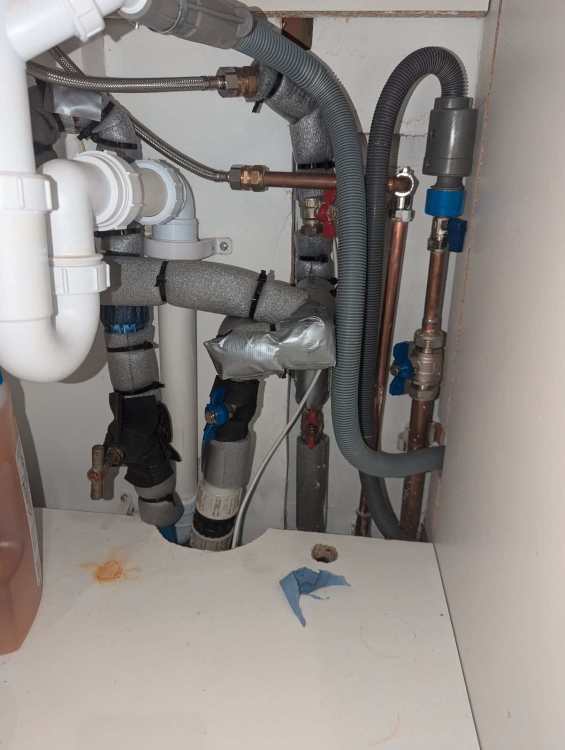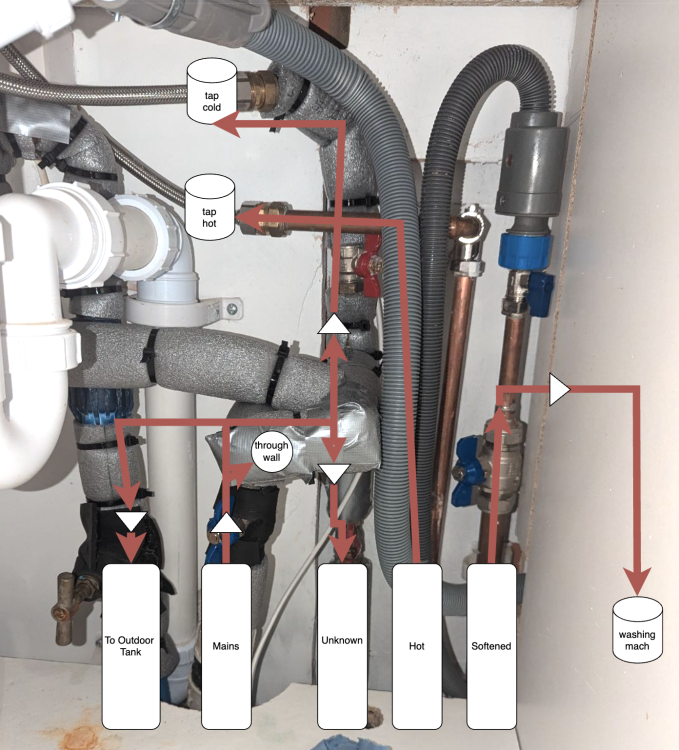-
Posts
1575 -
Joined
-
Last visited
-
Days Won
1
Everything posted by puntloos
-

Retrofitting an AC unit onto a wall not designed for it
puntloos replied to puntloos's topic in General Structural Issues
A small update: The AC guy will draw an outline of AC location and put pipes to it. Carpenter will come in to raise the pipe, possibly needs to lengthen it AC guy claims he can align some (but not all) loadbearing screws to the actual frame, and drive a few screws into plasterboard as mild support. But I think maybe I should just let my carpenter reinforce the frame (with noggins/plywood) behind the AC and then put plasterboard back for the AC guys to attach final thing -

Retrofitting an AC unit onto a wall not designed for it
puntloos replied to puntloos's topic in General Structural Issues
This was my thinking too, the problem is the AC guy might not be skilled enough to do this on the spot. I'm wondering what he could do that is 'reasonable' I'm debating: A/ He could cut the AC shape out of the existing plasterboard, and fit it directly on the frame (incl a few noggins/plywood flush with the frame perhaps). And yes, raise the outlet. After that, perhaps skilled decorators can close the gaps between AC and existing/damaged plasterboard. B/ He could use a stud finder to find the frame without removing plasterboard, and somehow align the support of the AC with the frame. Basically how could an 'amateur carpenter, pro AC guy' do a good enough job that the skilled carpenters/decorators can make it all look nice - obviously one worry is that an f-gas installed unit can't just be briefly disconnected by carpenters to do work. -
So I have a multi split outdoor AC unit, and can easily (...) add one more internal AC unit. So far so amazing. But, the perfect place to put the AC unit has two major issues: 1/ The AC unit is a bit too big, if I put the AC unit the lowest it can go, it would overlap the MVHR outlet by about 25%, assuming I change the current 'fancy, adjustable, sticky-outie' outlet with a flat grate. * a/ would overlapping the AC unit over perhaps 25-30% of the grate be an unacceptable hack? I suspect the amount of air it supplies would still be fine? * b/ I could move the air supply up, but it'd be quite the operation... 2/ This stud wall is not designed to hold an AC unit. * c/ Would you try to attach the AC unit to the frame (note the pipe is attached to the batons, but the frame in front should be fine to hold the 15kg) or * d/ Would you attach plywood to the frame, and then attach AC unit to it? (but that would mean redesigning the vent too..?) * e/ Would you attach the AC unit to the material behind the wooden frame? You'd need very VERY long screws/plugs, plus I'm not 100% sure the material behind can even hold plugs+screws that can hold 15kg.. I'm fairly sure there's a steel beam there One more pic of the buildup
-
Thanks @Redbeard and @Nickfromwales - so sorry I left this for a while./ The thing going through is a R32 AC pipe, which typically is perhaps 5cm diameter. Yes there's render, k-rend. My main problem is that now the house is effectively finished and we're retrofitting one more AC, they have only very little interest to come over.. they will, but "in their own good time" which could be ages from now. Should I perhaps just buy FM330 foam, spray the hell out of the hole the AC team leaves, and then hope someone comes in later and does it properly? My wall buildup is attached:
-
The point about octopus tariffs possibly going away is a fair one, but assuming they stick, a few notes: - The best use of solar is to bridge the octopus 4pm-7pm peak. You can both export previously acquired kwh at a great rate, plus you can avoid paying a premium to buy kwh. - My 10kwh battery will carry my all-electric house typically until 1am. My base load of the house is typically ~600W. (I have a few servers, 2 ASHP etc). - Reminder to factor in battery wear to your calculations. I once debated charging extra battery capacity during the low period, then discharging it at high (basically 1 extra cycle per day!), but when factoring in the cost to replace the battery after X/2 cycles basically it stopped making sense - My plan is to use my hybrid inverter to also take power from my car battery (V2H). Waiting for an affordable, approved V2H setup. (V2G seems not worth it, much more complex) - Reminder that most solar setups do not cover you for power outages unless your installer knows what they are doing. You'll probably need a high current contactor or 3 (I have 3 phase).
-

A2A + A2W ASHP or a more powerful A2W ASHP?
puntloos replied to puntloos's topic in Air Source Heat Pumps (ASHP)
Ha, sorry during the vacation break I haven't been paying much attention to BH, sorry. But yes, @joth got things correct, just to add a bit of colour, the main reason for going 2-system was that I couldn't find a dependable way to run FCUs off a A2W at the time I was researching it. It seemed possible in theory (and joth and others are living proof it is possible). At the time the only system that claimed it could do it all was a panasonic based system with very elaborate water routing plumbing. As such I would also imagine there would be a lot of magic, and potentially efficiency-killing switching between UFH, DHW and FCU. And, I certainly was not going to trust UFH to cool my home sufficiently, especially since I have a lot of SE-facing glass. My heat camera says the air from my FCUs is usually about 13C by the way. The FCUs I selected were very specifically the lowest noise in the industry, but that probably impacted the amount of cooling they can do, eg about 1C/hour at 5pm (so sun still there) for a 40sqm room. -
One of our passivhaus rooms is unexpectedly getting warmer than we hoped, and as such we will have to add one more fan coil unit. The challenge is that the aircon team isn't really well versed in passivhaus, so I'm trying to find a guide on how to drill a hole into a passivhaus wall and then sealing up the gaps left by having a hole with a pipe. To my understanding so far I have: - Pro Clima Tescon Sprimer Spray Primer - Orcon F - Passive Purple Airtight Liquid Vapour Control Membrane Spray - Contega Solido SL tape or (and?) Tescon No 1 tape And steps: 1/ Drill, clean drill site. 2/ Fix aircon pipe in place 3/ Fill large gaps with filler (orcon F?) 4/ Apply Primer 5/ Purple membrane spray (2 layers) 6/ Cure for 48 hours 7/ Tape with the Shingling method 8/ Rainscreen cladding somehow? To protect the tape? 9/ Perhaps finish for visuals? Is the above correct? I'm especially fuzzy what it looks like when an outdoor wall (with its render?) has a bunch of tape stuck to it? Or is there some way to eg apply render over all this?
-
Indeed, it's on the todo list - I'm sure we'll get to it when things get moving again.
-
Not a huge heat pump (8.5kw - decent?) but indeed I think the major problem the device has is that the temperature (as measured, at least) in the tank fluctuates so quickly that when the ASHP thinks it's done, the next time it needs to start up is pretty soon after. As can be seen in the graphs the pump really only runs for ~20 minutes, regardless of what target temp I set it to. Case in point: At 11:09 the difference between target and actual is 5C, and the ASHP (mitsu logic) switches off at 23:25 or so, almost immediately when it hits the target temp. What I am wondering here - if the ASHP is being asked to provide 40C water, and the tank approaches that 40C, can't it just keep running at 40C for a decent amount of time? Or will not being able to lose the coolant heat to the tank heat quickly enough be more inefficient still? Frankly I'm still trying to make sense of the overall temp in my tank. The amount of temperature loss due to a short shower is massive. Eg this is my kid today showering for, it seems, about 10 minutes, and the tank drops from 48 to 30. The showers are clearly not "eco" but they are also not excessive wrt the amount of water we are talking about. (also my water pressure is 3bar)
-
OK Inline, I'll do heavy editing to keep it shortish currently 40 (sensor says 42), no immersion. Overheating, interesting, I might check the top if I can. Stop> worth an experiment. Poor measurement, yea Mitsu only provides energy consumption over a day. And yes, the device switches on fairly often per day because the temp seems to drop below the treshold (eg set to 42, dropped to 36) but indeed seems to be done heating quite quickly, it seems to say it heats "the 400L tank" (again, sensor in the lower pocket) 6 degrees in 12 minutes, en then switches off. Also, one thing I noticed is that even if we're not using hot water, there's a somewhat immediate steep drop of tank temperature after heating, only then to mellow out: Could it be the heating is pretty focused around the area where it measures, and then when the tank mixes, it starts averaging out, only then to drop more gently? By "maxed out" do you mean it's heating at a super high target temp? Will try setting it to 50 (cheap) 10 (noncheap).. maybe that will help. I worry that the sensor might think we reached 50 too early and just stop, but if we're coming from a low temp it might work Yes, seems like we have the same consumption yet I seem to struggle (although of course bigger tank, more heat loss)
-
Reviving this thread, so my system is underperforming, I feel. Passivhaus (so not a ton of heating needed) with a bit of fancy smarthome magic (loxone, mainly) I'm pulling the ecodan data daily and plotting it. In short - I don't understand my 1.3 COP for DHW, and I feel this is not good enough for the installer to claim they did their job correctly. From this thread, if I would hit a 2.0 COP for DHW I guess that's not uncommon (but still...). At COP 1.3 I'd probably have been financially better off if I used an immersion heater for the coming 40 years before I recoup the ASHP.... What do you think? Is DHW COP 1.3 reasonable? More detail: As you can see the numbers fluctuate a lot (ignore the unexplained dip I guess) but I'm sitting at about 2.7 COP for UFH and 1.3 COP for DHW. My flow rate was in trouble for a while, but we unclogged a major pipe somewhere and nowadays it's a steady 20L/min so that's basically fine. Right now we're probably at one of those 'shoulder' seasons, where there's not a huge amount of UFH so it's probably not worth looking at but here's what I'm doing with DHW. Yellow = set temperature (admittedly this is slightly buggy, I wanted to set the temperature even lower during the expensive power window) but unimportant Green = actual temperature as measured fairly low in the 400L tank. As you can see I only really heat once a day for 2 adult showers, and that should be a pretty good burst, but it's obvious the ASHP is also doing regular work maintaining the temp. With a 400L tank and measuring low in the tank, it's an interesting question what the real 'average' temp of the entire tank is at any given time. Perhaps I need to move my temperature sensor to the top, or add another one? Anything strikes as weird? How can I debug this?
-

(ASHP-based) Hot water tank gets cold surprisingly quick
puntloos replied to puntloos's topic in Boilers & Hot Water Tanks
OK it's been a while but I have a bit of extra research, what I need to know: Is the current behaviour reasonable or should I complain? In short: - If tank temperature (as measured at the lowest slot (*) in tank) is ~49C or above, bath tap water is ~43C. This is hot enough. - If tank temperature is ~43C, bath tap water is ~39C (**). This is not hot enough. I'd say 42 is the lowest tap temp that works for filling a bath. In conclusion the mixer valve is probably set to 42-43C, but is not able to provide fully unmixed hot water, since if the tank is 42, it only produces 39. (does that mean it might be broken? or just 'cheap' or 'configured incorrectly'?) So- the question is, is the mixer, and its setpoint reasonable for a house with ASHP-temp water? When looking online, the NHBC Guidance suggests "bath taps will need a thermostatic mixer to ensure the temperature of the water leaving the tap will not exceed 48oC" so I don't understand why anyone would set the mixer to 43 unless it's (as per Health and Safety gov uk) "where vulnerable people can get access to baths or showers and the scalding risk is considered significant, a thermostatic mixing valve (TMV) Type 3 must be fitted to prevent water being discharged at more than 44°C" To my read the TMV for my bath should've been set to 48C, just like my shower right next to it, but they set it to 43 which is incorrect. What do you think? Is it actually incorrect, or at least 'unusual' to set a TMV to 43C for normal houses where there are no vulnerable people that could get scalded without being able to react? -M (*) while it's measured at lowest slot, I was sure to measure after temp stabilised a bit so I think it's likely fairly accurate. As you can see below I did my test at 14:30 so it's probably correct. (**) after 5 minutes of running it reached 39. 39 is barely enough to be a comfortable bath, but the bath itself is cold initially, so when you actually get in you're going to be a bit chilly fairly, not to mention that if the bath is (say) 36C, adding 39C water is barely moving the needle up again. s $ -

(ASHP-based) Hot water tank gets cold surprisingly quick
puntloos replied to puntloos's topic in Boilers & Hot Water Tanks
Just for clarification, I'm still tweaking my tank and heating etc. Of course (?) 37 is not my normal target temperature, for indeed just comfort, but also legionella reasons. Instead I have pretty close control over the target temperature, as indicated in yellow, vs the actual temperature, where indeed at 18:15 my kid showered, and at 23:00 two adults showered. The point of the curve was to raise the temp a little before 16:00 (elec is expensive between 16:00 and 19:00) to just have enough for that one shower), and let it cool a good amount between 0000 and 1600. even though the exact shape of the curve isn't right yet, the drop for my kid's shower was more than I expected, but as @JohnMo noted, perhaps it isn't incorrect or behaving poorly, it's just a lot of water that might not be as hot on average as I'm expecting. -
So my current tank is 400L. Pretty sizeable! Yet when it starts at 37C, having one shower on, drops the measured temperature down to 29 in 5 minutes. Is that normal, or could there be something plumbed wrong? To be clear: - I know 37C is pretty low to start with, it was semi-intentional (I figured leave it cool a bit during the expensive period) - Because 37 is already low, the shower user (my kid) probably tried to set it to max temp, so no other water mixed in. - The temp sensor is halfway up the tank, so presumably there's hotter water above the sensor, yet the kid complained the water was (slightly) too cold indeed after 5 minutes. Is this about within expectations? Of course the ideal tank temp is perhaps more like 53-55 (or way higher if gas-heated, 65?) but I still feel that having 400L of 37C water should.. in theory.. last a pretty long while - 12L/minute, so maybe we lost (and replaced with cold water) 60-100L over those 5 mins...
-

Undercapacity A2A outdoor unit - possible? advisable?
puntloos replied to puntloos's topic in Air Source Heat Pumps (ASHP)
Exactly, I feel the same way, it'd just be very strange if it wouldn't work at all. And 2.5 is the lowest powered indoor unit in the entire range, so 6x2.5 is already way over. But somehow it's listed as 'wont work'. Hm I should call mitsu to confirm. -

Undercapacity A2A outdoor unit - possible? advisable?
puntloos replied to puntloos's topic in Air Source Heat Pumps (ASHP)
Anyone? Or am I out of luck? -

Undercapacity A2A outdoor unit - possible? advisable?
puntloos replied to puntloos's topic in Air Source Heat Pumps (ASHP)
Has anyone tried this with Mitsubishi units? -

Undersink terrible plumbing and water damage?
puntloos replied to puntloos's topic in General Plumbing
I was wondering about this. Maybe it always leaked rather than that there ever was major condensation... Yea, so currently they are actually leaking, and they need to fix a mistake (they connected mains to our utility sink, we want softened there) so now's as good a time as any to demand them to re-do it, or is that too much? -

Undersink terrible plumbing and water damage?
puntloos replied to puntloos's topic in General Plumbing
Nah the stain is 'ok' (clearly damage but not a worry). I'm looking more at this: with paint peeling away (and mould?), and the pipe itself also looking a little... warty. One very important thing I believe is more psychological than anything - as renters you simply never look critically at 'service areas' - the understair cupboard, the meter closet etc. As a homeowner with a new build I'm thinking should I be picky about pipes that are 'working fine' but a bit grotty looking? We can hide this view behind a cupboard thing and ta-daa.. but I also (esp. with water dripping deep into the house stuff like I mentioned) worry that bad visuals translate to problems down the line? -

Undersink terrible plumbing and water damage?
puntloos replied to puntloos's topic in General Plumbing
Oh like you said, just saying that the condensation all comes from metal (like you said probably copper, or maybe aluminium?) and plastic (edpm? pvc?) will not condensate but might break sooner? Or is that a myth? -

Undersink terrible plumbing and water damage?
puntloos replied to puntloos's topic in General Plumbing
Good, that's comforting, although indeed water or soaking the concrete in my foundation .. problem? I think the important part is that MDPE/plastic is "fine" but my pipes seem to be metal-y. Metal is more sturdy, plastic is less drippy? I've been told that the risk with plastic-y pipes is that they will crack at some point. True? -
The plumbing under my sink has been an absolute headache since forever, this is a new house, and a picture of the current state is below (at the bottom an illustration of what's what.) My problem, there have been a few leaks, water has certainly dripped past the pipes, probably into the foundation of the house. Perhaps not a *ton* but probably at least 20 litres. Also the site is really continuously damp, condensation from mains that will go straight back down into the foundation where mains comes from Potential problems: Some good amount of liters of water with no 'obvious' place to go, sitting under house somewhere? Or is that totally fine, or are foundations perhaps designed to get rid of water over time? Damp pipes - the builder claims the cold mains is impossible to completely lag to prevent condensation, but I'm concerned the pipes embedded in my foundation will rust and at some point burst on me? Not sure how you would fix basically a burst mains somewhere below the house... Thoughts? Frankly I think a proper plumber needs to redo this entirely. My question, how would you do this better? Given there's so many valves, as an amateur I would probably use something like this - https://www.reliancevalves.com/gb/en/products/flow-control/plumbing-strainers-flow-regulators-manifolds/potable-water-manifolds Or perhaps this would constrain mains too much so keep the 'main bend' into the wall intact but do all the undersink work with a manifold like this? Given that there is a current leak (the valve to 'unknown' is probably damaged) is dripping, perhaps this is a great moment to redo it all? Or is the current state not that unreasonable and I'm just imagining things? Note there's an invisible-in-this-pic bend right above the mains that goes through the wall, which is really the main inlet to the rest of the house (buffer, softener etc is on other side of the wall). I actually don't know what the pipe right next to the mains does.. embarassing
-

Undercapacity A2A outdoor unit - possible? advisable?
puntloos replied to puntloos's topic in Air Source Heat Pumps (ASHP)
Yup. I'm running into one very weird one, which is that it says my particular outdoor unit - Mitsubishi MXZ-6F120VF2 - and (of course, figures.. ) - my selected indoor unit type, the SEZ-M25DA can't exceed the ratio of 1:1 max power usage. This makes very little sense. Why would only one specific unit type not be able to exceed 1? Either it's a limitation of the outdoor unit (apparently not), or they deliberately broke the M25DA and not the M35DA? -
With a Mitsubishi MXZ-6F120VF2 - which has 6 connectors for indoor units, however with its 11.2kW, the simplest math says that my 3x 2.5kW and 1x3.5kW indoor units already add up to 11kW. Does this mean that this unit can't add more units because the total demand would exceed 11.2kW? Or would it be totally fine, it's just that in the extreme (rare?) case that all units demand cooling, the actual temperature drop for each given unit would be less than optimal? Happy to hear advice on this.. even in the peak of summer last years, only 2-3 units were working at any given time, and even that was rare..


